In the next couple of weeks, I’ll be migrating this site to a new home! Check it out here.
Author: Brendan
Day 3: Trinidad
On our way out of Cienfuegos, our group stopped at the Tomas Acea Cemetery, a beautiful collection of graves of both powerful leaders and common people. Our friendly tour guide told us about the Cuban tradition of bone cleaning: the deceased’s survivors gather at the grave site periodically to honor their dearly departed by cleaning the remaining exhumed bones. Supposedly, this can be quite a sight to see when a casanova passes away; sometimes his mistresses will come along to participate, too.
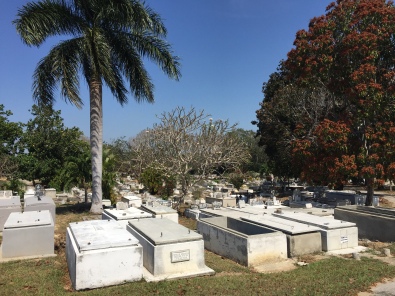
Graves at the Cementerio Tomas Acea
After arriving in Trinidad and dropping our things at the casa, we had pizza and drinks in a swanky private restaurant nearby. We decided to spend the rest of the day exploring central Trinidad, first stopping in a cigar and liquor shop (state-run, of course). The front part of the shop was quite stuffy in the afternoon heat, but the back area was refreshingly cool (so as to not harm the carefully crafted cigars that sat inside). I decided to wait until later in the trip to buy, lest my expensive cancer sticks expire in the oppressive heat.
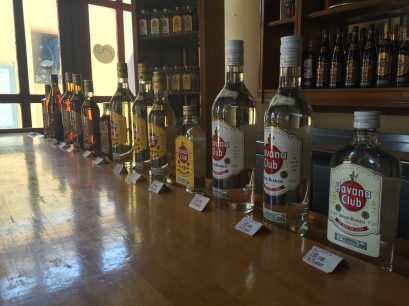
Cuban rum proudly on display
As we wandered around town, we passed the lovely Plaza Mayor and La Casa de la Musica. Trinidad is know for having lively nightlife, particular in regards to live music, which we would see firsthand later. Down the street, we visited El Museo de la Lucha Contra Bandidos, a building and bell tower that’s perhaps one of the more recognizable sights in Trinidad and the former home of the convent of Saint Francis of Asisi. The small museum inside has exhibits explaining counterrevolutionary efforts that occurred in the 1960s (it turns out two can play the revolution game). We climbed the bell tower, which affords excellent view of the city and surrounding countryside.
We stopped in a casa de santos, one of the names for a religious house for the practice of Santeria. Santeria is one of the most popular religions in Cuba and is loosely based upon Catholicism.
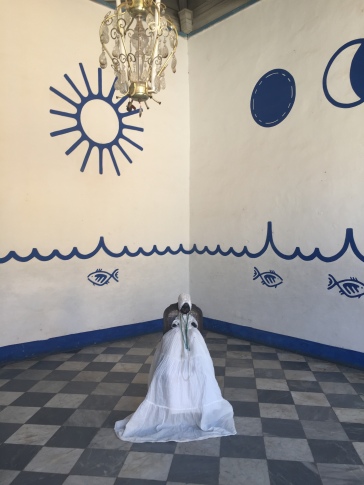
In the casa de santos. I’d be lying if I said I don’t have nightmares of this scene.
Later in the day, we grabbed some beers from the neighborhood market and headed to the beach to watch the sunset. It was a breathtaking scene and I was glad to be able to share it with my new friends.
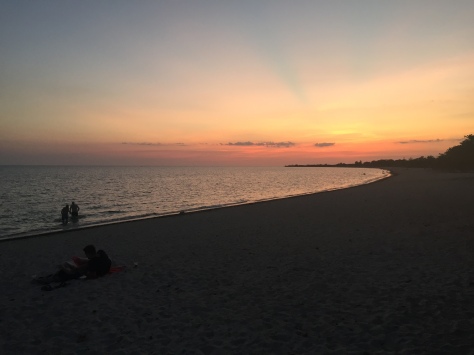
Enjoying the scenery at Playa Ancon
After a little siesta, our group gathered for dinner at a newspaper-themed restaurant for dinner. (I couldn’t help but appreciate a bit of irony in this.) I enjoyed a flavorful lamb burger with mango chutney and the restaurant treated us to a wonderful dessert of flan after dinner to celebrate the birthday of one of our group members. They even sang her a birthday song! It was kind of like a trip to Chili’s on your friend’s birthday, except more special, less expensive, and, ya know, in Cuba.
We decided to hit up some nightlife after dinner. One of the more famous establishments in Trinidad is Disco Ayala, a nightclub that’s housed in a deep cave at the top of a steep hill. After climbing what seemed like an endless route of ascending streets and then the hill, we stood at the entrance of what seemed like a pretty empty club. I was a bit skeptical as we paid cover – where were all the rowdy tourists and locals that we’d been promised? However, as we descended down into the cave, the music rapidly got louder, and suddenly we turned a corner to find a massive dance floor full of people getting down to a mix of Western hits and local favorites. Our crew danced the night away, and after closing time, we made some friends on the way back to the casa at a bar built into the side of someone’s house. We were 100% sober, I promise.
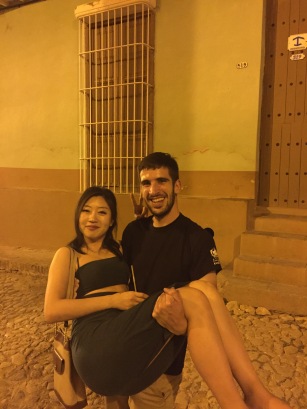
In good spirits, so to speak, after many hours out on the town
Day 2: Bay of Pigs and Cienfuegos
After a solid night of sleep in the casa, I woke up to the smell of breakfast cooking. Most casas include breakfast or will provide it for a small fee, and the fare was pretty similar (almost eerily similar, actually) throughout the trip: a plate of fresh fruit, eggs cooked the way you want them, bread with butter, coffee, thick fruit juice, and more. Our group made a point of trying to eat a lot for breakfast so we could coast along until dinner with only a light midday meal in between. Plus, with such a nice spread for breakfast, who could hold back anyway? (Not this American, I’ll tell you that.)
We had agreed to try to head out fairly early, so at around 9, our taxi and driver, José, arrived. Our motley crew of seven plus our guide made us just small enough to fit into a minivan taxi for the week. It was cosy, but certainly not uncomfortable and definitely added to the experience.
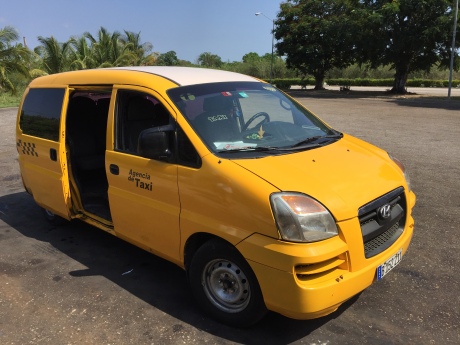
Our wheels for the week. Not pictured: the man, the myth, the legend: José.
As we headed out of Havana, I reviewed the itinerary for the coming week: it was going to be an action-packed trip that would take us to some of the more well-known cities in western Cuba.
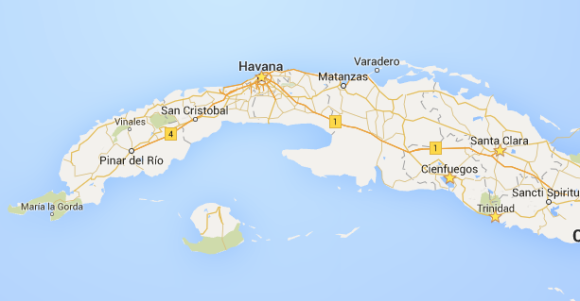
A map of the cities I visited on my trip: Havana, Cienfuegos, Trinidad, and Santa Clara.
We made a couple of stops on our way from Havana to Cienfuegos; the first one was at a sinkhole and beach. Most of us paid 5 CUC to rent snorkeling gear and tried our luck first with the sinkhole, but after not finding many fish there, we headed across the road to the beach. We also met a enterprising guy offering the chance to scuba dive for a low price, but nobody took him up on his offer. It felt great to get some sun on my milky midwestern skin.
After finishing up at the beach, we continued on to the Bay of Pigs museum, located near Playa Girón, one of the two main sites of the Bay of Pigs invasion in 1961. I’m no history buff, but if I had to guess, I’d imagine that the version of events that I got in this museum was probably a little different than what is taught to U.S. youngsters. A fun fact for you: the name “Bay of Pigs” comes from a literal translation of “Bahia de Cochinos” – the more logical English meaning of cochinos refers to the triggerfish that are commonly found in the reefs around Cuba.
After learning about the Cuban take on the invasion, our group took the opportunity to climb on some tanks outside the museum (don’t tell!).
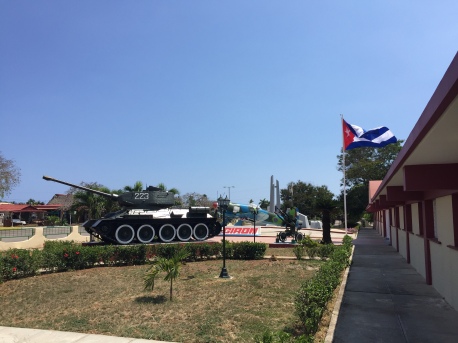
There was no shortage of tanks at the museum.
We then continued on to Cienfuegos, a city that is widely considered to have retained much of the design and charm of earlier days in Cuba; the central district is a UNESCO World Heritage Site. It’s also a great example of Spanish colonial architecture and city planning, employing a grid system that makes it easy to find your way around.
We soon arrived at our casa, a charming and spotless establishment close to the city center and the ocean. After dropping our bags, we ventured out, beginning the afternoon with drinks and snacks at a bar along the water. There was a live band covering Beatles tunes – I especially enjoyed their take on “Yesterday.”
In the central district, we checked out several historic artifacts, including a statue of writer and activist Jose Marti.
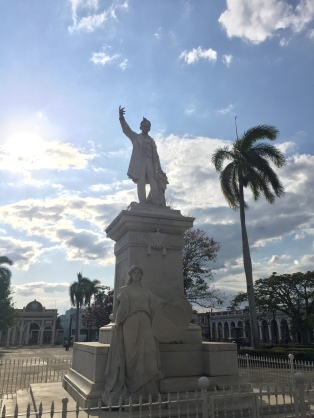
Statue of José Martí in central Cienfuegos.
We ventured to the prado, which took us all the way down to the Palacio de Valle, an elaborate early 1900s structure that showcases Moroccan architecture. The Palacio offers sweeping views of the ocean and is a great place to take in a drink and the sunset.
Venturing back into town, we stopped at the Cienfuegos Yacht Club, which is housed in a stately building that gives the impression of wealth in a country where ostentatious shows of money are fairly rare. We enjoyed a lovely meal at a modest restaurant down the street serving ropa vieja (literally translated, “old clothes”), a simple and yummy beef dish that hit the spot after a very active day. We capped off the night with beers and good company along the ocean (no pictures of this, as my rum-driven photography skills are sadly quite subpar).
Day 1: Arrival in Havana
I woke up on April 25 on a luxurious bed in an air conditioned room in Mexico City. Because my tour started on a Monday, I had decided to spend the weekend prior in Mexico City, a city I had never visited before, and I treated myself to a room at an upscale hotel in the neighborhood of Polanco, one of the toniest parts of town. Although I tend to take vacations as opportunities to be active and experience life as a typical local, I had also been craving some “me” time and thus indulged before my ongoing travels to Cuba.
After a quick shower and farewell to my insanely comfortable mattress, I headed off to the airport. Within what seemed like only a few minutes, I was touching down in Havana, Cuba. After deplaning, I was pleasantly surprised by the quick immigration process, during which the agent confirmed with me that I actually wanted my passport stamped. Apparently, many Americans are hesitant to do so, but I figured if Obama had come to Cuba, I was probably not striking all future chances of government employment by doing so (that would come later from my pictures with multiple Che Guevara statues).
I had arranged an airport pickup in a classic open-top car (because…American in Cuba) with a fellow traveler, Morgan, who was arriving from Venezuela. While I waited for Morgan and the car, I attempted to convert my U.S. dollars to CUCs, a Cuban currency primarily used by tourists. The key word is “attempted” – the line stretched around the arrival pickup area.
After ditching my plan to obtain local currency, I found Morgan, and eventually our driver arrived. He was a friendly guy who led us back to the parking lot to a charming ’52 Chevy that had seen better days but was certainly a looker. As we pulled out of the airport, the driver spotted an a dude who looked very lost and yelled, “Hey China man! Hop in! We’ll give you a ride downtown!” – an offer that was politely declined. That was one of the most interesting things that I observed in Cuba – the lack of hesitancy toward describing people by their physical characteristics (or perceived ethnicity). It’s not that Cubans are judgemental, racist, or anything else – it’s just convenient to describe someone as “the fat lady” or “China man”. I even had this pulled on me, as several Cubans decided that I looked German and called out, “hey, Germany!”. Donald Trump would like Cuba in this regard, I think.
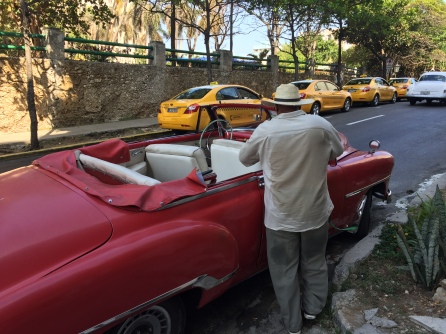
Our stylish ride from the airport to the casa.
After a short ride, we arrived at our homestay accommodation. Throughout the trip, we stayed at these casas particulares, as they’re called. The arrangement is pretty similar to a bed and breakfast but the true meaning of the term and its legal implications are somewhat unique to Cuba. Our casa for this warm Monday evening was across the street from the Hotel Nacional (arguably the most famous hotel in Cuba) and had incredible views of both the hotel and ocean.
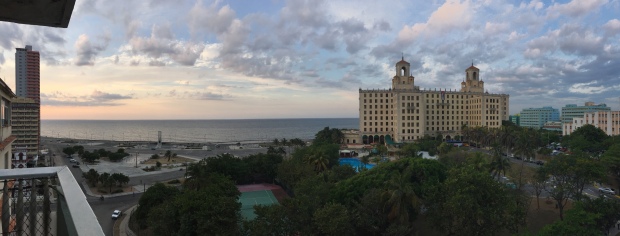
View from the casa. The Hotel Nacional is the large building on the right.
After a quick visit to the exchange bureau at the Hotel Nacional (that extra 10% tax when exchanging USD was fun to see in action), the host of my tour, Alistair, took Morgan and me to a bar down the street to try our first Cuban beer (meh) and mojito (yay). We were joined by Roy, who hails from the Netherlands and was returning from a day of exploring. After a couple of drinks, we decided to head down the street to the local Coppelia, a branch of the chain of subsidized ice cream parlors introduced in the 1960s by the Cuban government in an attempt to increase dairy consumption.
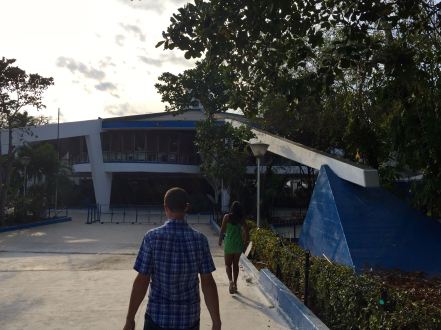
Entering Coppelia in search of cheap ice cream.
The Coppelia location in Havana could be described as a palace; it’s a massive compound taking up at least a a city block in all directions and can apparently hold over a thousand people when at full capacity. Given that you’re paying around 15 cents USD for a hulking tower of ice cream, service is about as eager as you’d expect. Most Cubans employed in standard state jobs make about $1 USD per day – so I couldn’t blame those who didn’t seem to be in any particular hurry. Low wages, hot weather, and lack of competition explain why places such as Coppelia remain quite popular in Cuba.
After coming back to the casa and having a quick nap, we headed out for a group dinner at a lovely privately-run restaurant located in a nearby apartment. There’s a stark contrast between public and private businesses – you can tell when there’s an entrepreneurial Cuban running the show rather than a bureaucrat. However, due to ongoing difficulty in sourcing various ingredients, you always have to have at least two choices of entree in mind when dining out in Cuba, as it’s fairly likely that your first choice will be out for the day.
After dinner, our tour group (which had grown to its full size of 7 tourists plus Alistair and his girlfriend) headed down to the Malecón, making a quick stop for beers at a street vendor on the way. The ocean wall is a popular night hangout for Cubans, and despite it being a Monday evening, it was crowded with musicians looking to play a song for a few pesos. After some fun conversations with locals curious about we were from, we walked down the shore a bit toward the U.S. embassy and then headed home to rest up for our early departure to Cienfuegos the next morning.
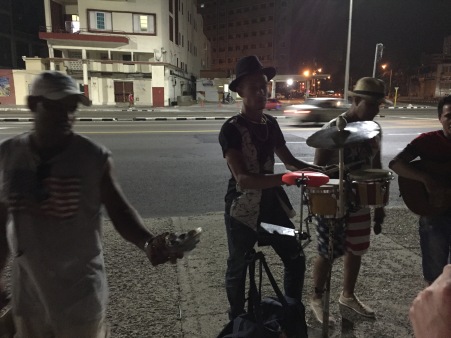
Eager performers along the ocean.
Cuba! #thanksobama
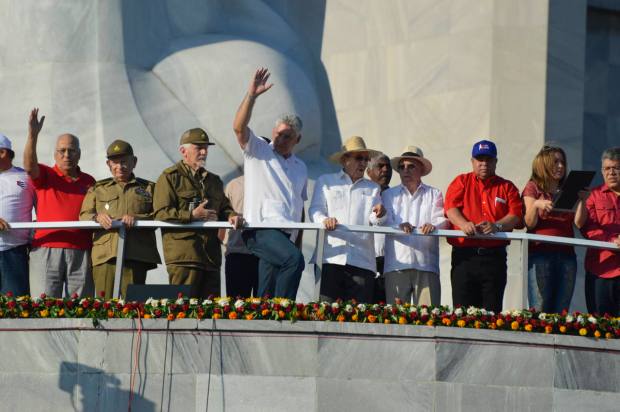
Getting a friendly wave from national leaders during the million-man parade on International Workers’ Day in Havana. Raul Castro is the guy wearing a straw hat and pointing. (Photo credit: Alistair Riddell)
Cuba is an interesting place for many reasons. It’s one of the few remaining Communist countries in the world but remains a popular tourist destination for many. It’s viewed with a sort of fetishism by many Americans, although the domestic perception of Cuba as a mysterious next-door neighbor is rapidly changing due to the Obama administration’s push for the advancement of U.S.-Cuba relations. President Obama seemed to be pretty well liked among the Cuban people I met, which was no doubt aided by his appearance in a couple of comedy sketches before and during his recent visit that were widely distributed and discussed across the country. I think a lot of the Cuban humor was over my head, but from viewing these clips, it’s clear that Obama wants to keep advancing these relations (a focus that has apparently not been consistently reciprocated by good ol’ Fidel).
On my last day in Cuba, a U.S. cruise ship docked in Havana for the first time in decades, and many U.S. airlines are seeking approval to operate scheduled service to Cuba. These are exciting times!
Anyway, I’ll be posting the details of my trip over the next few weeks. Enjoy!



